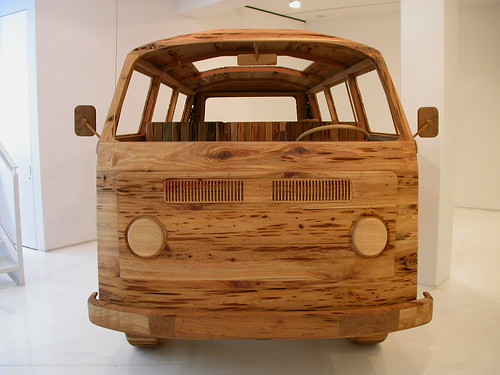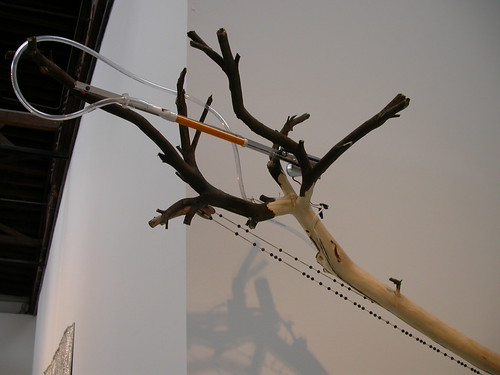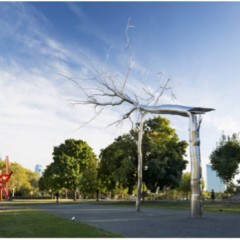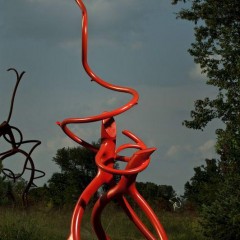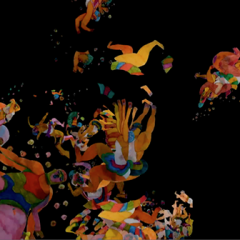Two gallery shows in New York and one public art project are having a nice conversation right now about sculptural objects and how vibrant that practice is. While the works by Lee Stoetzel, Tim Hawkinson and Roxy Paine couldn’t be farther apart in affect ultimately their points and purposes are not so far apart. All ruminate on nature and the unnatural, humankind and machinery — and the importance of materials to help tell a story. They’re all great.
Lee Stoetzel at Mixed Greens
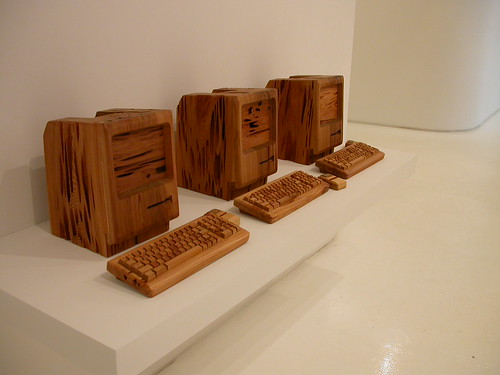
Lee Stoetzel’s computers, cypress pecky wood.
Lee Stoetzel makes finely-crafted sculpture out of wood. Among the pieces at Mixed Greens (to May 26) are what looks to be an almost life-size VW “hippie” bus, a Harley Hog motorcycle with those improbably high handlebars, and a bank of three early-model computers sitting on a desk as if in a student computer lab. My first reaction was to smile, and wonder at the intricacy of the works’ design and execution. I wanted to touch the work so loveable is it and so seductive, with its smooth, warm color and deep knots and holes.
Wood is a giving and generous sculptural material for the viewer. (I couldn’t say how it is to work with but it’s pretty clear Stoetzel loves it). Wood is real and familiar. It’s trees and nature — you can’t get more viewer-friendly than that.
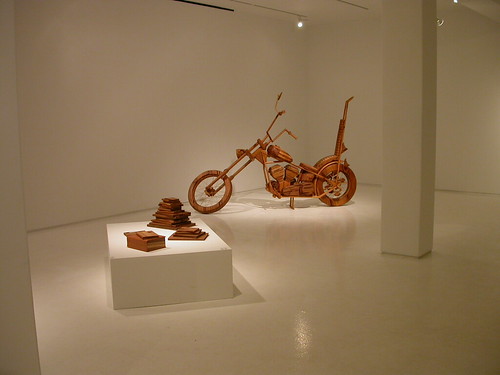
Motorcycle (rear) and wood books
Stoetzel’s works — made with pecky Cypress, a particular grade of wood with lens-shaped holes — are the embodiment, the apotheosis almost, of California Dreaming. With their lovely irregular holes, the wood has the appeal of driftwood. And the nostalgia-filled objects themselves — the VW bus, Apple Computer’s Neanderthal age machines and the Easy Rider motorcycle — are benevolent hallucinations denuded of gasoline, computer crashes, drugs, sex and rock and roll.
There’s machine-love in these pieces but there’s also a nod to the folks who made the real objects — the Harley workers and the rest — and a nod to those who bought and used them. Whether or not the machines have personal resonance for the artist, they are love objects — fetish objects even — here made into icons for worshipful reverie. Stoetzel is in a show at Abington Art Center right now. See Libby’s post.
Tim Hawkinson at Pace-Wildenstein
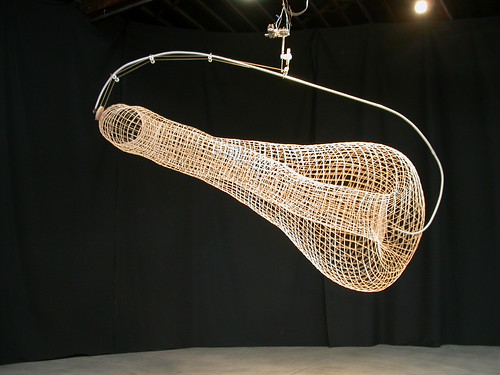
Tim Hawkinson, new work at Pace-Wildenstein. This mamoth work twirls slowly above your head and, with the black drape in back of it, evokes some useful object made in a 3-D cad program. It looks to be made of wicker (very thin basketry material)
Stoetzel’s objects have a calm quietude about them as if they were made over time in an orderly way. Tim Hawkinson, on the other hand, makes objects that are manic and frenzied and whose ambiance — often controlled by a mechanical addition that clacks, whirs and makes music — are as individual as human beings. In his new show at Pace-Wildenstein (to June 9) Hawkinson concerns himself with the body and especially with its orifices and appendages, its holes and sticky-outy parts that are miracles of engineering — and that often, when they don’t work, cause mighty troubles.

Detail of the above piece, sorry I didn’t take down the names of these objects.
Hawkinson is like a mad inventor, and his materials seem to come from anywhere and everywhere — the basement (cardboard boxes, tape, plastic twine) to the backyard (twigs) to Radio Shack for little motors and metal joints to hold it all together, to craft stores that sell wicker basket-making material. The artist also uses photography but he uses photographs as raw materials for more objects, here, he creates new types of body parts (a mouth, nose and ear inside an eye, fingers knit into a basket).

“Scout made from cardboard, box strapping, and urethane foam to form a “Buck Skin” outfit designed for a 6 foot tall sensory homunculus…” description from the gallery website.
One piece in the show is made of a long tree branch outfitted with a mechanism that sets a slide whistle in motion. The thing sounds like a crazy bird singing its heart out in the treetops in the morning. It’s a piece that makes me blush for loving birds so much. It also is a wonderful rumination on ingrained habits or instincts and how we all (including birds) do what we do often for genetic reasons. Birds can’t stop singing; some kids can’t stop putting beans in their ears; often people can’t stop talking. The infernal cycle of repetition is both good and bad. Mostly it just is.
Hawkinson, in his photo works takes the opportunity to push to the gross-out level. One after another shiny cut-and-pasted photo collage (mounted on foam and not framed or under glass) becomes a digression into the nightmare landscape of the mind where fingers can magically multiply and become woven like straw basket material. Or where a finger in a nose is embedded in an ear embedded in a mouth embedded in an eye.
EEEEEW.
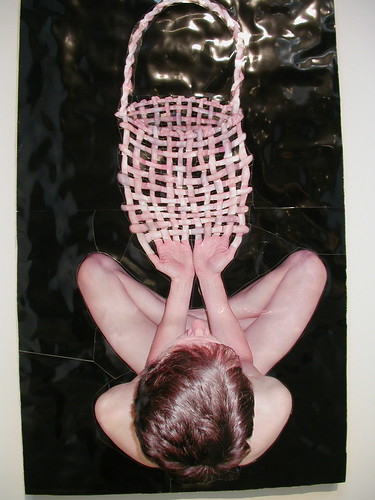
Hawkinson’s works are Dr. Frankenstein-like. The inventor is what-if’ing it, scrambling the sensory organs. Is sight the primary sense organ? Is hearing? How can you decide? This playful jiggering won’t help. If you get past the ugh factor there is really no news here. Just some cutting up.

Eye, ear, mouth, nose, finger — see it BIG to get the full effect.
This gallery by the way is the same that showed Rosalyn Drexler‘s paintings earlier this year — with walls placed quite differently — and before that Tara Donovan‘s plastic cup polar landscape, shown without any interior walls at all. Such complete transformation of a space is something I’ve only seen regularly at a museum like ICA, another concrete-floored cavern with infinite potential depending on how you slice it up. This is Hawkinson’s first solo exhibit with Pace.
Roxy Paine

Conjoined, by Roxy Paine, in Madison Square Park. Temporary installation for a year.
I saw another anthropomorphic tree sculpture, this one a public outdoor piece in Madison Square Park.
The tree is actually two conjoined trees made out of stainless steel components, by Roxy Paine. And the shiny silvery monument is a thing of glory there in the park. Real but not real. Who knows whether trees can be conjoined above ground. I think not. But this cantilevered bridge tree is not about the real world anyway. It speaks of interdependence and joinings and can be read less as a monument to weird nature than as a cautionary tale about nature in peril.
I love the vigorous object-making by these three artists and I wish we had more of it in the world. Something about the slow absorption of sculpture as you walk around it, where your body takes it in like an encounter with another being, is just right for this quick-paced I got it now let’s move on culture.


